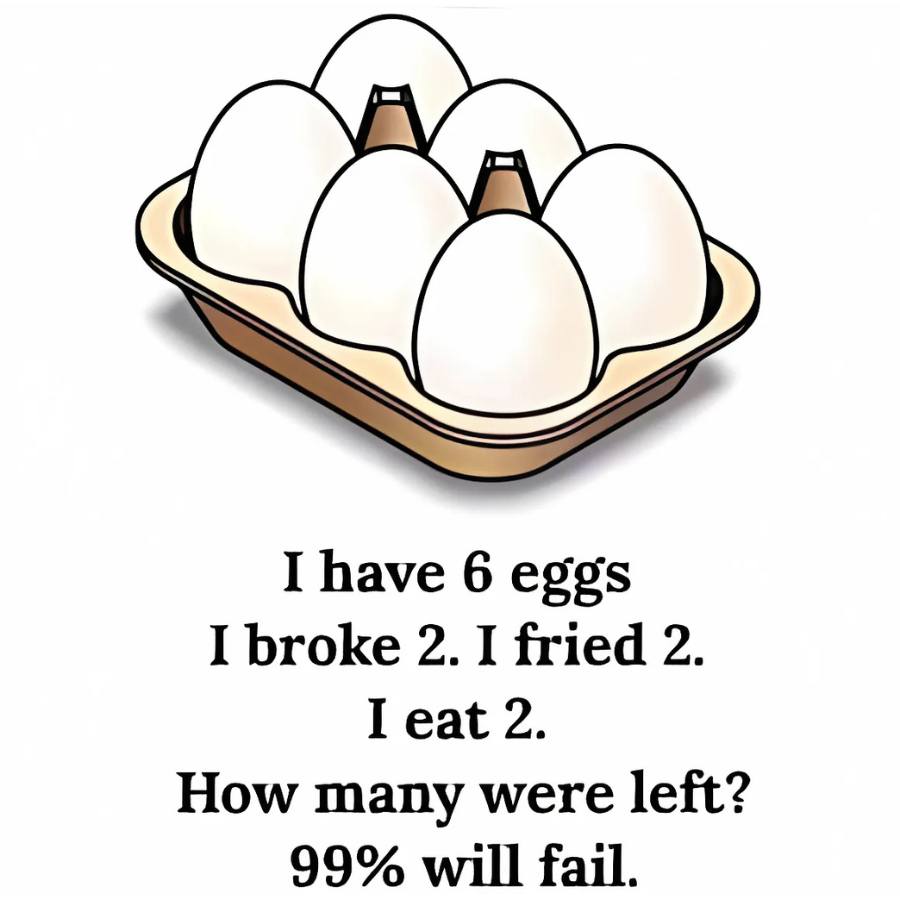Riddles have a unique way of making us think differently, sharpening our problem-solving skills, and challenging the assumptions we often take for granted. They may appear simple at first glance, but their tricky wording can leave even the most logical minds scratching their heads. One such classic example is the widely shared brain teaser: “How many eggs are left?”

At first, it seems like a straightforward math problem, but the clever phrasing is designed to mislead. Let’s dissect the riddle step by step, uncover the correct answer, and understand why it tricks so many people.
The Riddle Unveiled
Here’s how the riddle is presented:
- You have 6 eggs.
- You break 2 eggs.
- You cook 2 eggs.
- You eat 2 eggs.
So, how many eggs are left?
Most people assume that each action involves separate eggs—2 for breaking, 2 for cooking, and 2 for eating. With that assumption, it’s easy to conclude that all 6 eggs are used up. However, the twist lies in the riddle’s phrasing: it never specifies that different eggs are used in each step.
The Correct Answer: 4 Eggs Remain
The correct answer is that 4 eggs are left.
If that surprises you, you’re not alone. The key detail many overlook is that the same 2 eggs are broken, cooked, and eaten. The remaining 4 eggs remain untouched throughout the entire sequence.
Let’s break it down logically:
- Start with 6 eggs.
- All 6 eggs are whole and untouched.
- Break 2 eggs.
- Two eggs are cracked, leaving 4 whole eggs intact.
- Cook the same 2 eggs.
- These are the same eggs that were broken in the previous step.
- Eat the same 2 eggs.
- The same 2 eggs that were broken and cooked are now eaten.
By the end of the sequence, the 4 remaining eggs were never involved in any of the described actions.
Why This Riddle Is So Tricky
The confusion arises because the riddle plays on our natural tendency to assume each action applies to different eggs. When we hear “break 2 eggs,” “cook 2 eggs,” and “eat 2 eggs,” we instinctively think of separate eggs for each step.
However, the riddle cleverly misdirects us by not specifying that the actions involve different eggs. The sequence matters, and the same two eggs are used throughout, leaving the remaining four untouched.
Breaking Down the Logic Step-by-Step
For absolute clarity, here’s a step-by-step breakdown of the events:
- You start with 6 eggs.
- All 6 are whole and untouched.
- You break 2 eggs.
- Two eggs are cracked, leaving 4 untouched.
- You cook the same 2 eggs.
- The same eggs you broke are now cooked.
- You eat the same 2 eggs.
- The same eggs that were broken and cooked are now eaten.
At the end of the process, 4 whole eggs remain untouched.
The Lesson Behind the Riddle
This riddle isn’t just a fun puzzle; it’s a lesson in critical thinking and problem-solving. Here are a few takeaways:
- Pay Attention to Details: The riddle never specifies that different eggs are used for each action. The wording matters.
- Avoid Assumptions: Jumping to conclusions without analyzing the scenario leads to errors.
- Think Sequentially: Understanding how each action relates to the others is key to solving the puzzle.
These lessons extend beyond riddles and are valuable tools for tackling real-life challenges.
Why Riddles Are So Fun
Riddles like this one are enjoyable because they push us to think outside the box. They challenge our assumptions, make us question the obvious, and reward us with a satisfying “Aha!” moment when we finally figure it out.
Additionally, riddles are fun to share. Watching friends or family struggle with the same puzzle and then revealing the answer can lead to plenty of laughs and discussions.
The Next Time You Hear This Riddle…
The next time someone asks, “How many eggs are left?” you can confidently reply, “4 eggs.” Better yet, you’ll be able to explain your reasoning step by step, impressing everyone with your sharp logic.
Riddles like this remind us to slow down, pay attention to the details, and rethink our assumptions. Often, the simplest solutions are the correct ones—all it takes is a little patience and critical thinking.
So, now it’s your turn. Share this riddle with someone and see if they can crack the code. The joy isn’t just in knowing the answer; it’s in the journey of figuring it out!